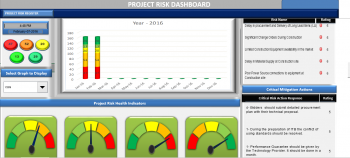Risk Register with Dashboard for Risk Communication

Risk communication is required and crucial to keeping Stakeholders in the loop regarding project health and progress. It is arduous to please higher management and other Key Stakeholders by communicating nebulous (vague) project Risk status.
Lack of communication is a top most factor that contributes to Risk growth. Wordy, pointless and lengthy power point presentations make no sense except a waste of time and resources to win the key Stakeholders confidence on a project. Absolutely, no need to create dozens of pages to satisfy Key stakeholders. Right decision at the right time is vital to keep the project on track with respect to schedule, cost, and other constraints. So, what to do when each key Stakeholder requires concise and precise presentation on a Risk status? The answer is a Dashboard!
A Dashboard provides well structure, concise and interactive solution. A dashboard is a right choice to highlight the Risk status and progress to communicate with Stakeholders and satisfy their requirement of Risk information.
I developed a Risk Register with Dashboard to address the project Risk management process as a whole.
Have a look at the video and provide your comments.
Answer to one of question asked in a forum:
"
A typical approach is used to calculate the Overall Project Risk or How Risky is the project. Different criteria are being used to define overall project Risk. In most of the organizations, if they're two or three Very High Risks (Major Risks), they declare the project as Risky or in danger. While in some of the organization, they use summing up the Risk score to declare the project in danger. According to my experience, considering the only risk score does not give the complete picture of a project to declare it as Risky or not, especially when any organization is evaluating many projects in line with portfolio comparing different portfolio to having an apple-to-apple comparison. Therefore, I defined a criteria for Overall Project Risk is i.e. :
Internal Risks Factors (Like Organizational Culture etc.) within Organization (risks arising from the events taking place within the organization) + External Risks Factors (Infrastructure etc.) outside or beyond the control of an Organization (risks arising from the events taking place outside the organization) + Project Risk Factors (Contract type etc.) including Risk ScoreNow the question is why these internal, external and project Risk Factors? The answer is Risk management is to reduce threats and enhance opportunities. Of course, these factors will be different from organization to organization. These factors should be reviewed periodically as KPIs are reviewed and updated on a regular interval. I have not used the combination of impacts to define overall Project Risk in this Register.
If we talk about the Safety Risk alone, then only one Risk is enough to kill the project. Consequence modeling results are so scary (QRA for Plant Safety) to imagine any sudden catastrophic incident within a short span of time. Although this is not the case. A single tiny leak or malfunctioning can lead to multiple fatalities in a plant. Therefore, the concept of Process safety Management has been changed to Risk-based Process Safety.Decision making for a complex or even for a simple project cannot be done only on the basis of Risk score alone."
Note: Open to discuss to implement this solution at the project as well as organizational level.
 Printer-friendly version
Printer-friendly version- Login or register to post comments
 Send to friend
Send to friend




